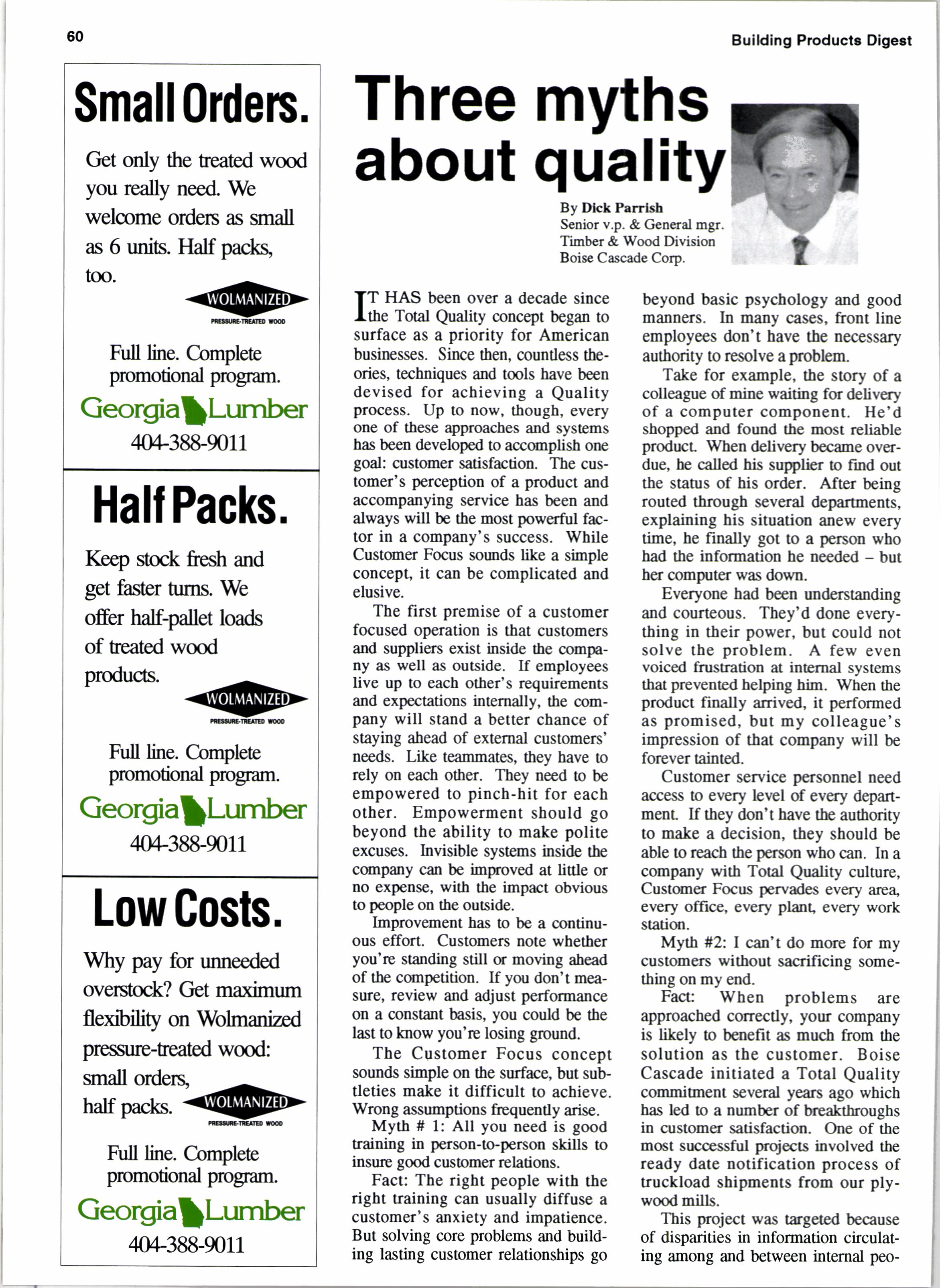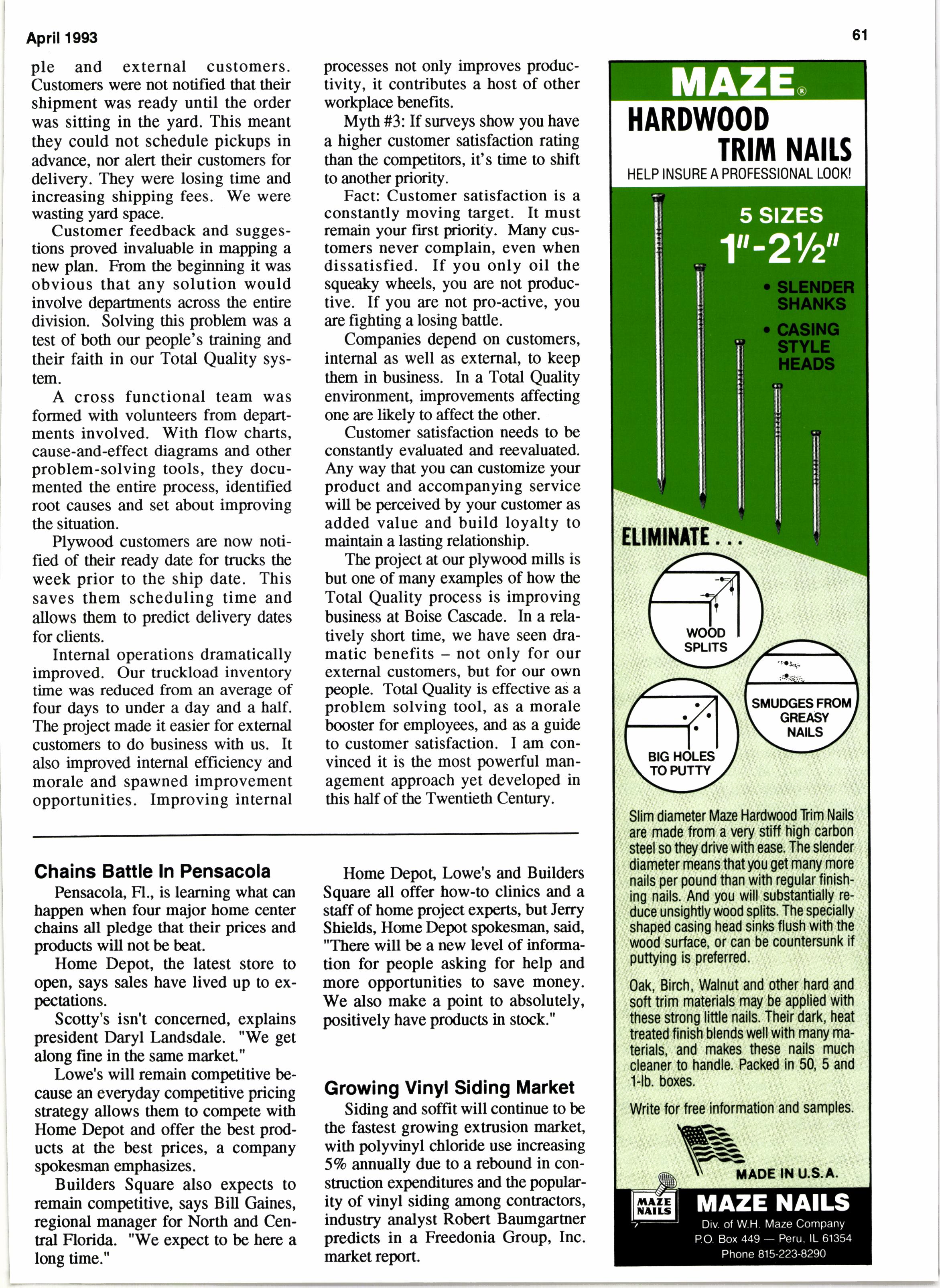
5 minute read
Small 0rderc. Three myths about quality
By l)lck Psrlsh Senior v.p. & General mgr. Timber& Wood Division Boise Cascade Corp.
fT HAS been over a decade since Ithe Total Quatiry concepr began o surface as a priority for American businesses. Since then, countless theories, techniques and tools have been devised for achieving a Quality process. Up to now, though, every one of these approaches and systems has been develo@ to accmplish one goal: customer satisfaction. The customer's perception of a product and accompanying service has been and always will be the most powerfrrl factor in a company's suocess. While Custmter Focus sornds like a simple concept, it can be complicated and elusive.
The first premise of a customer focused operation is that customers and suppliers exist inside the ompany as well as outside. If employees live up to each other's requirements and expec6ions internally, the company will stand a better chance of staying ahead of extemal customers' needs. Like tearrmates, they have o rely on each other. They need to be empowered to pinch-hit for each other. Empowerment should go beyond the ability to make polite excuses. Invisible systens inside the cqnpany can be improved at liule or no expense, with the imprct obvious to people on the outside.
Improvement has to be a ontinuous effort. Customen note whether you're standing still m moving ahead of the cmrpetition. If you don't measule, review and adjust performance on a oonstant basis, you could be the last to loow you're losing ground.
The Customer Focus concept sounds simple on the surface, but sub. tleties make it difficult to achieve. Wrong assumptions frrequently arise.
Myth # l: All you need is good training in person-to-person skills to insure good customer relations.
Fact: The right people with the right training can usually diffuse a customer's anxiety and impatience. But solving core problems and building lasting customer relationships go beyond basic psychology and good manners. In many cases, ftont line enployees don't have the necessary au0ority to resolve a problem.
Take for example, the story of a colleague of mine waiting for delivery of a computer component. He'd shopped and found the most reliable producr When delivery became overdue, he called his supllr o find out the status of his order. After being routed througb several departments, explaining his situation anew every time, he finally got to a person who had the information he needed - but her comprter was down.
Everyone had been mderstanding and courteous. They'd done everything in their power, but could not solve the problem. A few even voiced frustration at int€mal systems that prevented helping him. When the product finally arrived, it perforured as promised, but my colleague's impression of that company will be forever tainted.
Customer service personnel need access to every leral of every department If they don't bave the authoriry to make a decision, Oey should be able to reacb the person who can. In a company with Total Quality culture, Custmer Focus pervades every are4 every office, every plant, every work statim.
Myth #2: I can't do more for my customers without sacrificing something on my end.
Facc When problens are approached correctly, your company is likely to b€nefit as muci ftom the solution as the customer. Boise Cascade initiated a Total Quality commitment several yean ago which has led to a number of breakthoughs in customer satisfaction. One of the most swcessful projects involved the ready date notification process of truckload shipments from our ply11lggdmills.
This project was trgeted because of disparities in infonnation circulating among and between internal peo- ple and external customers. custmlers were not notified that their shipment was ready until the order was sitting in the yard. This meant they could not schedule pickups in advance, nor alert their customers for delivery. They were losing time and increasing shipping fees. We were wasting yad space.
Customer feedback and suggestions proved invaluable in mapping a new plan. From the beginning it was obvious that any solution would involve deparmrents across the entire division. Solving this problem was a test of both our people's raining and their faith in our Total Quality system.
A cross functional team was formed with volunteers from departments involved. With flow charts. cause-and-effect diagrams and other problem-solving tools, they documented the entire process, identified root causes and set about improving the situation.
Plywood customers are now notified of their ready date for trucks the week prior to the ship date. This saves them scheduling time and allows them to predict delivery dates for clients.
Internal operations dramatically improved. Our truckload inventory time was reduced from an average of four days to under a day and a half. The project made it easier for external customers to do business with us. It also inproved internal efficiency and morale and spawned improvement opportunities. Improving internal
Chains Battle In Pensacola
Pensacola, Fl., is learning what can happen when four major home center chains all pledge that their prices and poducts will not be beat.
Home Depot, the latest store to open, says sales have lived up to expectations.
Scotty's isn't concerned, explains president Daryl Landsdale. "We get along fine in the same markel" processes not only improves productivity, it contributes a host of other workplace benefits.
Lowe's will remain competitive because an everyday competitive pricing stf,ategy allows them to compete with Home Depot and offer the best products at the best prices, a company spokesman emphasizes.
Builders Square also expects to remain competitive, says Bill Gaines, regional manager for North and Central Florida. "We expect to be here a long time."
Myth #3: If surveys show you have a higher customer satisfaction rating than the competiton, it's time to shift to another priority.
Fact: Customer satisfaction is a constantly moving target. It must remain your first pnority. Many customers never complain, even when dissatisfied. If you only oil the squeaky wheels, you are not productive. If you are not pro-active, you are fighting a losing battle.
Companies depend on customers, intemal as well as external, to keep them in business. In a Toal Quality environment, improverrents affecting one are likely to affect the other.
Customer satisfaction needs to be constantly evaluated and reevaluated. Any way that you can customize your product and accompanying service will be perceived by your customer as added value and build loyalty to maintain a lasting relationship.
The project at our plywood mills is but one of many examples of how the Total Quality process is improving business at Boise Cascade. In a relatively short time, we have seen dramatic benefits - not only for our external customers, but for our own people. Total Quality is effective as a problem solving tool, as a morale booster for employees, and as a guide to customer satisfaction. I am convinced it is the most powerful management approach yet developed in this half of the Twentieth Century.
Home Depot, Lowe's and Builders Square all offer how-to clinics and a staff of home project expsrts, but Jerry Shields, Home Depot spokesman, said, "The,re will be a new level of information for people asking for help and more opportunities to save money. We also make a point to absolutely, positively have products in stock."
Growing Vinyl Siding Market
Siding and soffit will continue to be the fastest growing extrusion market" with polyvinyl chloride use increasing 5Vo annually due to a rebound in construction expenditures and the popularity of vinyl siding among contractors, industry analyst Robert Baumgartner predicts in a Freedonia Group, Inc. market report.










